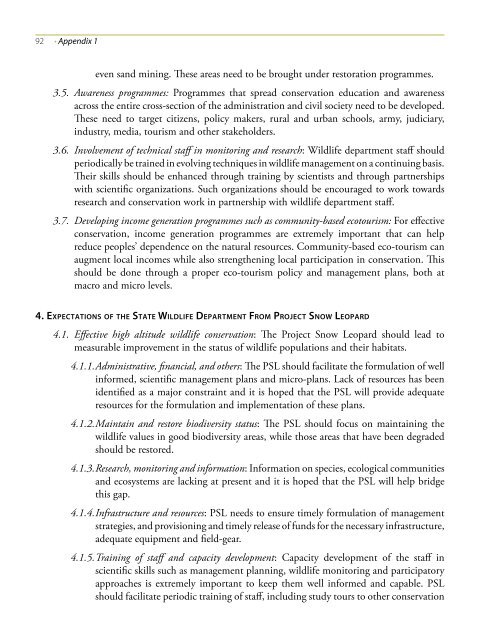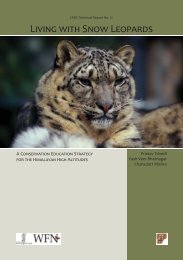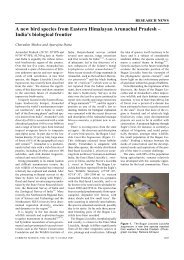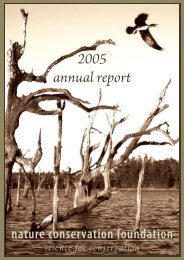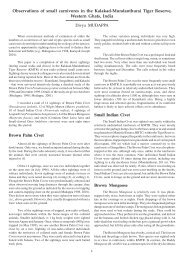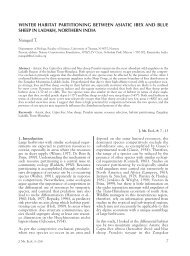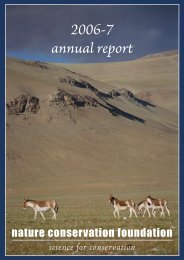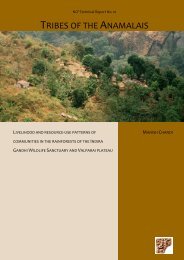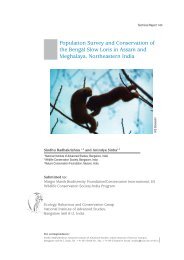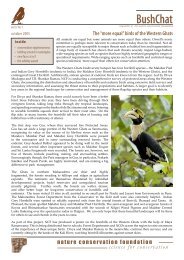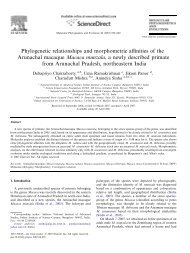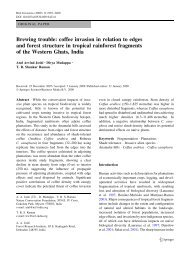towards project snow leopard - Nature Conservation Foundation
towards project snow leopard - Nature Conservation Foundation
towards project snow leopard - Nature Conservation Foundation
You also want an ePaper? Increase the reach of your titles
YUMPU automatically turns print PDFs into web optimized ePapers that Google loves.
92 • Appendix 1<br />
even sand mining. These areas need to be brought under restoration programmes.<br />
3.5. Awareness programmes: Programmes that spread conservation education and awareness<br />
across the entire cross-section of the administration and civil society need to be developed.<br />
These need to target citizens, policy makers, rural and urban schools, army, judiciary,<br />
industry, media, tourism and other stakeholders.<br />
3.6. Involvement of technical staff in monitoring and research: Wildlife department staff should<br />
periodically be trained in evolving techniques in wildlife management on a continuing basis.<br />
Their skills should be enhanced through training by scientists and through partnerships<br />
with scientific organizations. Such organizations should be encouraged to work <strong>towards</strong><br />
research and conservation work in partnership with wildlife department staff.<br />
3.7. Developing income generation programmes such as community-based ecotourism: For effective<br />
conservation, income generation programmes are extremely important that can help<br />
reduce peoples’ dependence on the natural resources. Community-based eco-tourism can<br />
augment local incomes while also strengthening local participation in conservation. This<br />
should be done through a proper eco-tourism policy and management plans, both at<br />
macro and micro levels.<br />
4. Expectations of the State Wildlife Department From Project Snow Leopard<br />
4.1. Effective high altitude wildlife conservation: The Project Snow Leopard should lead to<br />
measurable improvement in the status of wildlife populations and their habitats.<br />
4.1.1. Administrative, financial, and others: The PSL should facilitate the formulation of well<br />
informed, scientific management plans and micro-plans. Lack of resources has been<br />
identified as a major constraint and it is hoped that the PSL will provide adequate<br />
resources for the formulation and implementation of these plans.<br />
4.1.2. Maintain and restore biodiversity status: The PSL should focus on maintaining the<br />
wildlife values in good biodiversity areas, while those areas that have been degraded<br />
should be restored.<br />
4.1.3. Research, monitoring and information: Information on species, ecological communities<br />
and ecosystems are lacking at present and it is hoped that the PSL will help bridge<br />
this gap.<br />
4.1.4. Infrastructure and resources: PSL needs to ensure timely formulation of management<br />
strategies, and provisioning and timely release of funds for the necessary infrastructure,<br />
adequate equipment and field-gear.<br />
4.1.5. Training of staff and capacity development: Capacity development of the staff in<br />
scientific skills such as management planning, wildlife monitoring and participatory<br />
approaches is extremely important to keep them well informed and capable. PSL<br />
should facilitate periodic training of staff, including study tours to other conservation


